Note from the LeftEast editors: this article is published in cooperation with the Serbo-Croatian web portal Bilten.Org
In recent weeks the miners are back again: This time not on the streets, but on the public agenda. The Romanian High Court, following a decision of the European Court of Human Rights reopened the file dealing with the events of 13-15 June 1990 in Bucharest. After 25 years of stalled investigations, the prosecutors decided it is time for a fresh look. Two things are clear. First, this decision cannot be separated from the current wave of arrests shattering the Romanian political class. It continues the frontal attack of the judiciary against the post-communist governing elite.
Secondly, the main figure targeted by the reopening of this file is the former president Ion Iliescu, believed to be the mastermind behind the events and their main beneficiary. The decision to reopen the case should be saluted in the hope that at least this time some light will be shed. However, there is the risk of conflating juridical truth with historical truth. As always, the latter is much more complicated and disturbing.
13 June 1990
It is the morning of 13 June 1990. In Piata Universitatii, the center of Bucharest and an iconic place of the 1989 revolution, around 200 people are protesting against Ion Iliescu and his newly elected regime. The protests started during the electoral campaign of that year, but after the vote held on May 20, which Iliescu won with a landslide (over 80%), only a handful of dedicated opponents remained in the square.
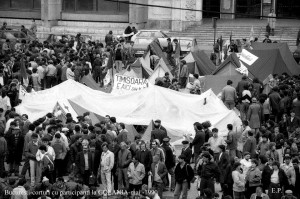 Some would camp here; others would go home for the night, only to show up the next day to the protest. They accuse Iliescu of stealing the elections and of installing a neo-communist regime. The protesters demand his resignation and new elections. But towards the end of May and the beginning of June the energy seems to have run out. Only a handful of anti-communist intellectuals are still trying to animate spirits and the social composition of the protesters is clearly more homogenous (young students) than it was at the beginning. By now, for many people in Bucharest, the prolonged protests in the city center have become more of a nuisance and a curiosity than a real point of interest. However, what seemed to be another regular day of protest, soon turned out to be one of the most contentious days in the history of Romanian post-communist transition.
Some would camp here; others would go home for the night, only to show up the next day to the protest. They accuse Iliescu of stealing the elections and of installing a neo-communist regime. The protesters demand his resignation and new elections. But towards the end of May and the beginning of June the energy seems to have run out. Only a handful of anti-communist intellectuals are still trying to animate spirits and the social composition of the protesters is clearly more homogenous (young students) than it was at the beginning. By now, for many people in Bucharest, the prolonged protests in the city center have become more of a nuisance and a curiosity than a real point of interest. However, what seemed to be another regular day of protest, soon turned out to be one of the most contentious days in the history of Romanian post-communist transition.
The exact unfolding of the events is itself part of the dispute. Very early morning, so it all begins, police forces entered the square with the aim of disbanding the tents and shelters of the protesters. Scores of street cleaners waited in the back to clean up the place afterwards. However, at this point something went amiss –on this topic speculations abound – and the police intervention became violent. Protesters respond by throwing stones and Molotov cocktails and by setting on fire police and television cars. The police are forced to backtrack, allowing the protesters to take initiative and set ablaze the central station of the Bucharest police. By afternoon, the city center is heavily under smoke and the situation clearly out of control.
Enter the miners
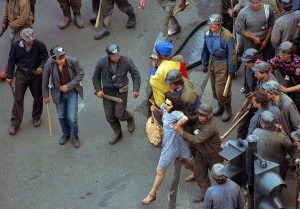
After a speech made by Ion Iliescu at the national television – the only one at the time – in which he condemned the attacks in Bucharest as a coup d etat attempt, scores of miners from Valea Jiului – the main concentration of mining industries in Romania – began to board trains to Bucharest in order to defend the order. They arrived in Bucharest the next morning, armed with clubs and determined to put things right. Hundreds of locals from Bucharest await them with flowers. They run havoc in Piata Universitatii, beating not only protesters but also people who remotely look like one. They destroy the headquarters of the main opposition parties and some buildings belonging to Bucharest University. Since many of the protesters are professors and students there, the University is considered to be one of the main culprits.Random passersby and some Roma neighborhoods also became targets of the miners. In total 8 people were left dead and over 700 injured. The city center was destroyed and international public opinion was in shock.

Ion Iliescu remained composed: after the miners accomplished their mission around the city, on June 15 he thanked them for their efforts and civic consciousness and wished them a good return home. In orderly fashion, and with air of a job well done, the miners boarded the train back home.
These three summer days decisively marked the post-communist career of president Iliescu and set the foundation for the main theme of Romanian transition: that of a struggle between retrograde, conservative, brutal neocommunist forces and progressive, European, intellectual anti-communist groups. This is one of the reasons anti-communism was such a powerful political, intellectual and ideological tool during Romanian post-communism, managing to displace, obliterate and subordinate other social struggles to a belated fight against communism. Prior to that, the Romanian revolution was depicted as a popular uprising that was “stolen” by the neo-communist forces, embodied by Iliescu.
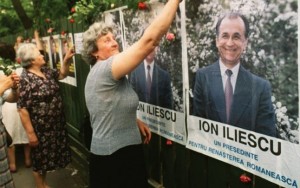 The events of 13-15 June 1990 represented only the brutal confirmation that this was indeed the case. By constructing the Romanian transition as the mastermind of neo-communists – indeed as the outcome of a failed anti-communist revolution – the anti-communist forces of the transition were able to monopolize the discourse about justice and change. Transitional justice entailed punishing the perpetrators of communist and neo-communist crimes, thus dismissing any concerns with transitional injustices. Similarly, economic and social reforms were aimed at severing the communist’s grip on state and economic power. Therefore, the neoliberal transformations of the transition, under the auspices of anti-communism, took a moral tone as well: they were not simply economic and political reforms in line with the Washington consensus, but a moral duty to purge the nation of communists. The current anti-corruption campaign has it initial roots in this type of thinking: neo-communists were corrupting the nation economically (by securing key positions after 1989), politically and morally.
The events of 13-15 June 1990 represented only the brutal confirmation that this was indeed the case. By constructing the Romanian transition as the mastermind of neo-communists – indeed as the outcome of a failed anti-communist revolution – the anti-communist forces of the transition were able to monopolize the discourse about justice and change. Transitional justice entailed punishing the perpetrators of communist and neo-communist crimes, thus dismissing any concerns with transitional injustices. Similarly, economic and social reforms were aimed at severing the communist’s grip on state and economic power. Therefore, the neoliberal transformations of the transition, under the auspices of anti-communism, took a moral tone as well: they were not simply economic and political reforms in line with the Washington consensus, but a moral duty to purge the nation of communists. The current anti-corruption campaign has it initial roots in this type of thinking: neo-communists were corrupting the nation economically (by securing key positions after 1989), politically and morally.
Ion Iliescu is indeed the typical communist apparatchik. He joined the party as a teenager. His father, also a devoted communist, was pushed to an early grave by his own comrades during the internestine fights of the party in the 1940s. This did not prevent Ion from having an astounding career within its ranks such that by the early 1970s he was regarded both as a key person of the regime, and as a non-dogmatic, moderate, pro-western one. Having attracted the wrath of Ceausescu, he was therefore sidelined in minor positions during the 1970s and 1980s. This, however only enhanced his popularity among Romanians and also abroad. Radio Free Europe identified him as the most desirable replacement for the decrepit Ceausescu in the second part of the 1980s. A soft-spoken advocate of Gorbachev’s reforms, Iliescu never became an open opponent of the Romanian dictator. He waited in the wings for the right moment to act. This moment came during the 1989 Revolution when, amid the chaos and power vacuum generated by the flight of the Ceausescus, Iliescu, with the sang-froid and savoir-fair of an old apparatchiks, took power.
But if Iliescu appeared to be a fresh face compared to Ceausescu, Iliescu too cut a warn-out figure when the latter was gone. Instead of carrying the promise and enthusiasm of the new world, he became the guarantor that the old world will go gently. This is more than a figure of speech: it represented Iliescu’s political strategy and the pillar of his statesmanship. Initially, Iliescu misperceived the underlying root of the Romanian revolution and its historical significance. He set out with the goal of implementing a Perestroika-like reform program. But one cannot administer treatment to a dead patient. The communist system was gone and there was no turning back. Change was inevitable. Therefore, instead of denying this obvious fact, Iliescu sought to be the spearhead of the change. His basic impulse was to seize and maintain political power. If the overall trajectory was out of his own hands, he could at least maintain political power for himself and his acolytes. He chose the possibility of his own political reproduction over having a real say in the direction of the transition.
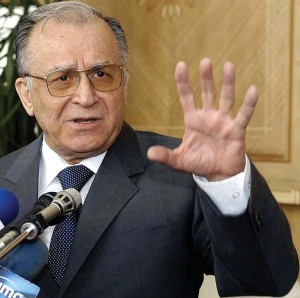
In order to consolidate his control of state and political power, Iliescu employed two strategies. First, he empowered lower level but essential figures of the former regime by allowing them to formalize their positions: that is, to become local owners of capital via the privatization process. This linked their business interests with the state and aligned them with the interests of the political power controlling the state.
Secondly, Iliescu made sure that the social base of the Communist Party (the industrial working class and their families) would not become alienated and would support his regime. These, of course, were from the start contradictory positions (the privatization of state assets would hit the working class the worst), but the contradiction would be played out in a time span longer than Iliescu’s constitutional time at the helm. Instead of the shock therapies that characterized other countries of the Eastern Block, Romania developed a series of subordinating and paternalistic relations that led to the creation of a local class of capital owners, powerful at the local level but overall dependent on the central political power for the accumulation process. In turn, this local class of capitalists had to act paternalistically in relation to the working class since this constituted the electoral base of their political patrons. This arrangement lasted at least until 1996, when Iliescu lost elections for the first time, challenged by a neoliberal coalition promising shock therapies. Inevitably, following these harsh policies, the pendulum swung back, which led to Iliescu’s reelection in 2000. His former electoral base still had power.
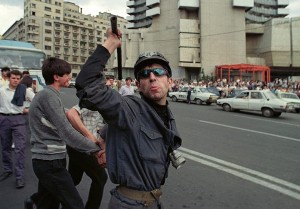
The coming of the miners in Bucharest in June 1990 was neither the first nor the last of such actions. There were six mineriads (as they are called in Romanian) in total. The coming of miners in 1991 led to the resignation of Prime Minister at that time, Ion Iliescu’s main rival. The events in June 1990 were arguably the most violent –a fact that also contributes today to the calls for their investigation – and attracted wide popular and media attention.
It is clear now (as it was perhaps clear even back then) that these events were part of the strategy of the regime to consolidate its power by intimidating the opposition and by orchestrating a top-down class struggle. The working-class miners were pitched against the middle-class, intellectual urban protesters of Bucharest. It was the clear sign about where the regime’s allegiances in terms of class were. Moreover, the regime managed to manipulate the fears of the wider population so that, with a few exceptions, the miners’ actions were largely supported across the country.
However if one looks back with hindsight, the real losers, and, better said victims, of the transition, were not those beaten up in Piata Universitatii, but the miners, and more generally, the working class. Already by mid 1970s the miners entered in conflict with the state, because the communist state, just like in other places across neoliberal Europe, was trying to shut down the coal mines. The first really significant anti-Ceausescu strikes happened in Valea Jiului in 1977. Despite the tough repression that followed, the rebellious spirit of the miners was never quashed, nor did their social situation improve. As a social class they were bound to disappear in the long run. This made them vulnerable to manipulations coming from the political power sweet promising them a swift salvation, but also from local political entrepreneurs who sensed that the context was ripe to advance their own ambitions – as it was the case with Miron Cozma, the 1990s leader of the miners.
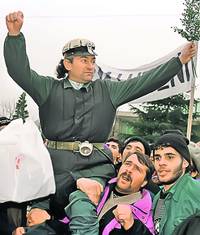
Before eventually ending up in jail, he toyed with the image of a popular politician and leader of the disenfranchised but determined working classes.
After the events of June 1990, the miners became the epitome of working class brutality, backwardness and retrograde communism. This perspective anesthetized the public to the social catastrophe that happened in Valea Jiului once the mines were closed and political power did not need the physical power of the miners for its own purposes. An entire population became extinct during the transition period and no one seemed bothered, or even remotely interested, about it. Now that the files are open again, perhaps the court will indict some people who were responsible for these events. Maybe, even Ion Iliescu will face charges –something that the whole nation seems to expect and desire. But one thing is for sure: no court will ever say anything about, let alone indict anyone, for the social tragedy of the miners, and of the working class in general, during the transition. That story is the historical truth.


